 |
Fort Ligonier
Ligonier, Pennsylvania, USA
|
|
 |
Constructed: 1758-1760
Used by: Great Britain
Conflicts in which it participated:
French & Indian War,
Pontiac War
|
Named for a dude who never set foot in the western hemisphere, Fort Ligonier was, at the height of its occupation, the largest population center in Pennsylvania, second only to Philadelphia.In 1758, British Brigadier General John Forbes (1707-1759) was ordered to capture the French stronghold that was Fort Duquesne, at what is today Pittsburgh. |
 |
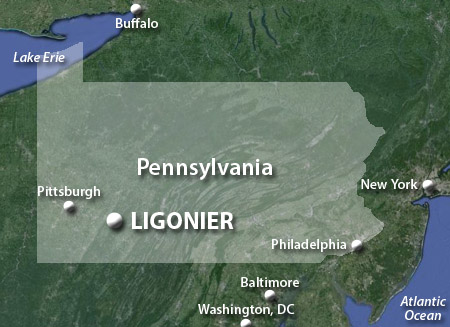 |
|
Commanding the fork where the Monongahela and Allegheny Rivers meet and create the mighty Ohio River, Fort Duquesne (good thing you don't pronounce the last few letters in many French words, because I would have no idea how to pronounce Duquesne otherwise) had been built by the French in 1754. This was at the very start of the French and Indian War (1754-1763), which is what Americans call the Seven Years' War (1754-1763). As this conflict betwixt Britain and France (and others, but really mostly betwixt Britain and France) was fought on every continent (except Antarctica, but then nobody important even knew there was an Antarctica until the 19th century: Surely Britain and France would have killed themselves trying to figure out a way to colonize it and oppress the nonexistent Antarcticans had they only known of the place), it was the first true world war.
|
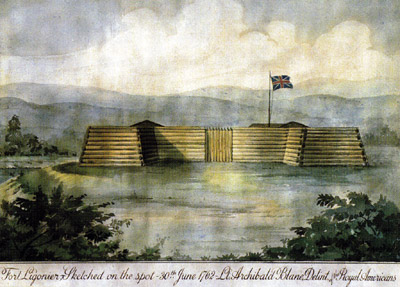 "Fort Ligonier, Sketched on the spot - 30th June 1762 - Lt. Archibald Blane Delint, of the Royal Americans" "Fort Ligonier, Sketched on the spot - 30th June 1762 - Lt. Archibald Blane Delint, of the Royal Americans" |
 |
But we're still talking about Fort Duquesne. In the interest of capturing this desperately important "gateway to the west," the British army led by General Forbes undertook a protected advance through the hostile territory of the New World. This maneuver took the form of a slow and careful consolidation of ground taken by the construction of outposts, supply depots and forts along the way.
The trail that was hacked through the wilderness towards Fort Duquesne was called the Forbes Road, and the final outpost on this road, to be used as a staging area for the ultimate attack on the French fort, was Fort Ligonier. |
|
|
Known for the first year of its existence as the Post at Loyalhanna for its location on Loyalhanna Creek (Delaware for middle stream), work on what would become Fort Ligonier began on September 3, 1758. Engineers planned to build an enormously strong fort of double, seven-foot-high log walls, set ten feet apart with the space betwixt filled with earth, but Forbes slapped them upside the head and pointed out that speed and simplicity were more important than massive invincibility in this case. The resulting compromise of construction would eventually become a spiny nightmare of pointy sticks, one that practically invites an attacking party to hopelessly impale themselves.
John Ligonier (1680-1770), namesake of the fort of our current interest, was a French-born devoteé of Britain who served in the British army for 60 years. In 1757 he was named Commander-in-Chief of the British military, and though Ligonier never left the British isles during the Seven Years' War, he did play an important role in strategy and planning of how that war was executed. Ligonier would have commanded the defense of Britain had the French invaded, as was considered a possibility in 1759 - and had he done so successfully, he likely would have had more stuff named after him than just a spiky wood starfort in Pennsylvania. Not that there's anything wrong with having a spiky wood starfort in Pennsylvania named after you, John.
|
While Forbes was on his way to the Post at Loyalhanna with the bulk of his army, before the fort was completed, the French and Indians from Fort Duquesne struck. On October 12, 1758, a force of 590 French troops and Indians first attacked a number of British troops stationed outside the Post at Loyalhanna to guard the fort's official animals as they grazed, then beat back the 200-man Maryland Battalion that the Anglo-American commanding officer, James Burd (1725-1793), had sent out to deflect the attack. The Maryland, Pennsylvania and North Carolina Provincial troops scuttled back into their fort, and artillery was brought to bear on the attackers.
|
 |
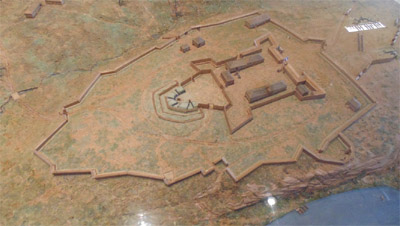 A diorama of Fort Ligonier in its heyday at that fort's lovely little museum. A diorama of Fort Ligonier in its heyday at that fort's lovely little museum. |
|
Unable to do anything to counter the unsportsmanlike introduction of artillery to the battle, the French and Indians retreated to the nearby woods, where they hunkered down until nightfall, sniping at anyone so foolish as to expose themselves. The attackers tried again at 9pm, expecting that darkness would completely negate the advantage that artillery conferred upon the British, only to find that it did not. The French and Indians, repulsed again, contented themselves with killing or taking away some 200 British horses, and returned to Fort Duquesne.
|
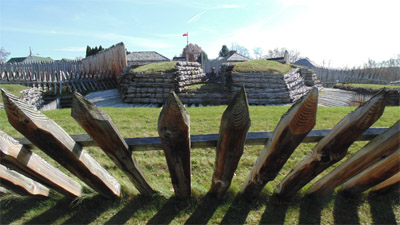 Fort Ligonier's Fascine Artillery Battery, definitely one of its most arresting sights. The restored, ever-so-bristly Fort Ligonier was the source of some of my favorite starfort pictures I've ever taken! Fort Ligonier's Fascine Artillery Battery, definitely one of its most arresting sights. The restored, ever-so-bristly Fort Ligonier was the source of some of my favorite starfort pictures I've ever taken! |
 |
Riding with General Forbes was a young Virginian officer named George Washington (1732-1799). Washington had been present for the Braddock Expedition, the British army's previous (failed) attempt to capture Fort Duquesne, in the summer of 1755. Shortly after taking up residence at the Post at Loyalhanna in November of 1758, Washington took part in a lively near-death friendly-fire event in which the unit with which he was patrolling and another British unit mistook each other for the French. 14 were killed and 26 wounded in this case of mistaken identity, but Washington was unharmed: Thank goodness! Who knows what language we might all be speaking now had Washington died in 1758? Serbo-Croatian, perhaps. |
|
|
Once Forbes' army arrived in November of 1758, 4,000 troops, craftsmen and other camp followers were camped at the Post at Loyalhanna, making it Pennsylvania's second-largest population center.
Forbes' master plan was to attack Fort Duquesne in the spring of 1759, but the fortuitous capture and interrogation of a couple of French soldiers who had been "lurking" near the Post at Loyalhanna revealed that the French fort was much depleted, and thus ripe for conquest! Though immobilized by a mystery ailment, Forbes had himself plopped into a handcart and ordered himself dragged immediately to Fort Duquesne for some derriere-kickin', British army style!
|
Amusingly, when Forbes and his troops arrived at Fort Duquesne on November 25, 1758, they found it abandoned and at least partially destroyed by the retreating French. Effusive in victory, Forbes named the place where his handcart now sat Pittsburgh, after British wartime political leader William Pitt (1708-1778), and officially renamed the Post at Loyalhanna, Fort Ligonier.
Our fort's advanced batteries were once again attacked by the French in the spring of 1759, without success. Fort Ligonier was then permitted to relax, uncontested, in a state of spiny attentiveness until the end of the French and Indian War in 1763.
|
 |
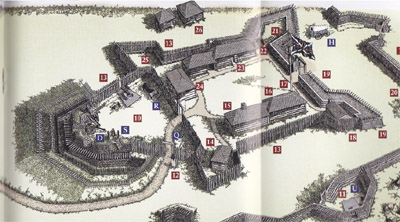 An absolutely gorgeous map of the reconstructed Fort Ligonier as it appears today, from Fort Ligonier: Official Guidebook and Map, which I was talked into purchasing at the fort's museum. Thank you, pretty museum lady! Click on it, it's huge. An absolutely gorgeous map of the reconstructed Fort Ligonier as it appears today, from Fort Ligonier: Official Guidebook and Map, which I was talked into purchasing at the fort's museum. Thank you, pretty museum lady! Click on it, it's huge. |
|
Great Britain emerged from the French and Indian War as the preeminent power in North America, which was great for anyone in North America of English descent, but not so great for Indians. Displeased with Britain's postwar policies, a loose confederation of fourteen Indian tribes, headed by Ottowa leader Pontiac (1720-1769), attacked a number of British forts and settlements in 1763, ultimately hoping to drive the British from the region.
|
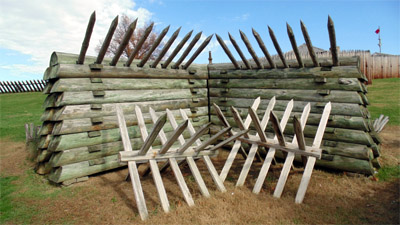 An obstacle at the opening in Fort Ligonier's southwestern retrenchment: Good luck getting past that if somebody inside were trying to prevent it! An obstacle at the opening in Fort Ligonier's southwestern retrenchment: Good luck getting past that if somebody inside were trying to prevent it! |
 |
During this conflict Fort Ligonier was twice attacked and "semi-besieged" by Indians, though never truly damaged. The former Post at Loyalhanna mostly served as a waystation for troops heading for the rising monstrosity that was Fort Pitt, Britain's new bastion of power that was being built next to the ruins of Fort Duquesne.
Fort Ligonier, eclipsed in both size and strategic location by Fort Pitt, was abandoned by the British in 1766. The post predictably enough fell into disrepair, and by the next time anybody went looking for it in 1830, few clues remained as to the fort's mighty existence. The town of Ligonier, however, had been initiated by the fort's presence. |
|
|
In 1946, the land on which Fort Ligonier had stood was purchased by the Fort Ligonier Association. Over the next half century, the fort was completely reconstructed, as accurately as possible. Today Fort Ligonier is a true wonder of threatening juttiness, with genuinely sharp stakes poking out in all directions. There is a small but very well-appointed museum dealing not only with the history of the fort itself, but also the Seven Years' War and its effect around the world. I visited Fort Ligonier in November of 2014! Please click here to read about my visit and view some of the 30,000 pictures I took in the Starforts I've Visited section!
|
|
|
|
|
|
 |




